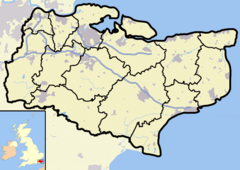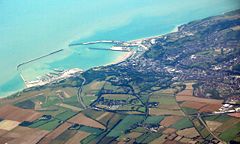Dover
| Dover | |
|
|
|
 Dover shown within Kent |
|
| Population | 28,156 (2001 Census) |
|---|---|
| OS grid reference | |
| - London | 77.8mi |
| District | Dover |
| Shire county | Kent |
| Region | South East |
| Constituent country | England |
| Sovereign state | United Kingdom |
| Post town | DOVER |
| Postcode district | CT15, CT16, CT17 |
| Dialling code | 01304 |
| Police | Kent |
| Fire | Kent |
| Ambulance | South East Coast |
| European Parliament | South East England |
| UK Parliament | Dover |
| List of places: UK • England • Kent | |
Dover is a town and major ferry port in the county of Kent, in South East England. It faces France across the narrowest part of the English Channel. The town is the administrative centre of the Dover District.
Its strategic position has always been evident throughout its history: archaeological finds have revealed that the area has always been a focus for peoples entering and leaving Britain, and this continues to this day.
Services related to the Port of Dover provides a great deal of the town’s employment, although many of the former ferry services have declined, meaning that unemployment tends to be higher than other parts of Kent. There was a military barracks in Dover, which was closed in 2007. Dover has a strong tourist base.
Contents |
History
Dover’s name originated with its river - the River Dour, deriving from the Brythonic Dubrās ("the waters"), via its Latinized form of Dubris. The Romans called it ’’Porte Dubris’’; the modern name was in use at least by the time Shakespeare wrote 'King Lear' (between 1603 and 1606), in which the town and its cliffs play a prominent role.
The town gives its name both to the surrounding chalk cliffs, which a form a gateway to the port; and to the narrow sea passage - the Strait of Dover - on which it stands.[1] The cliffs also gave Britain its ancient name of Albion ("white").
One measure of the importance of Dover's links with France is that only a few English towns/cities have names in French different from their English names: these are Dover (Douvres), London (Londres) and Canterbury (Cantorbéry).
Dover’s history, because of its proximity to France, has always been of great strategic importance to Britain. Archaeological finds have shown that there were Stone Age people in the area; and that by the Bronze Age the maritime influence was already strong. Some Iron Age finds exist also, but the coming of the Romans made Dover part of their communications network. Like Lemanis (Lympne) and Rutupiae (Richborough) Dover was connected by road to Canterbury and Watling Street; and it became Portus Dubris, a fortified port. Forts were built above the port; lighthouses were constructed to guide ships; and one of the best-preserved Roman villas in Britain is here.
Dover figured largely in the Domesday Book as an important borough. It also served as a bastion against various attackers: notably the French during the Napoleonic Wars; and against Germany during World War II.
Governance
Dover is represented in Parliament by the Labour MP Gwyn Prosser.
Dover Town Council is headed by its mayor, whose yearly term of office runs from May. The current mayor (2008-9) is Diane Smallwood; her predecessors are listed[2] The councillors represent the six town wards: Buckland; Castle; Maxton and Elms and Priory; St Radigunds; Tower Hamlets; and Town and Pier.
Geography
Dover is at the extreme south-east corner of Britain, at the nearest point to the continent, 22 miles (35.2km) away across the Strait of Dover.
The site of its original settlement lies in the valley of the River Dour, making it an ideal place for a port, sheltered from the prevailing south-westerly winds. This led to the silting up of the river mouth by the action of longshore drift; the town was then forced into making artificial breakwaters to keep the port in being. These breakwaters have been extended and adapted so that the port lies almost entirely on reclaimed land.
The higher land on either side of the valley - the Western Heights and the eastern high point on which Dover Castle stands - have been adapted to perform the function of protection against invaders. The town has gradually extended up the river valley, encompassing several villages in doing so. Little growth is possible along the coast, since the cliffs are on the sea’s edge. The railway, being tunnelled and embanked, skirts the foot of the cliffs.
Demography
In 1800 Edward Hasted (1732-1812) reported that the town had a population of almost 10,000 people[3]
At the 2001 census, the town of Dover had 28,156 inhabitants, while the population of the whole urban area of Dover, as calculated by the Office for National Statistics, was 39,078 inhabitants.[4]
With the expansion of Dover, many of the outlying ancient villages have been incorporated into the town. Originally the parishes of Dover St. Mary's and Dover St. James, since 1836 Buckland and Charlton have become part Dover, and Maxton (a hamlet to the west), River, Kearsney, Temple Ewell, and Whitfield, all to the north of the town centre, are within its conurbation.
Economy
Shipping
The Dover Harbour Board[5] is the responsible authority for the running of the Port of Dover.
The English Channel, here at its narrowest point in the Straits of Dover, is the busiest shipping lane in the world. Ferries crossing between here and the Continent have to negotiate their way through the constant stream of shipping crossing their path. The Dover Strait Traffic Separation Scheme allots ships separate lanes when passing through the Strait. The Scheme is controlled by the Maritime and Coastguard Agency of HM Customs, whose headquarters is at Langdon Battery in Dover[6]
The Port of Dover is also used by cruise ship passengers, and the old Dover Marine railway station building, together with a newly built one, cater for those passengers[7]
The ferry lines using the port are (number of daily sailings in parentheses):
- to Boulogne: Speed Ferries (5);
- to Calais: P&O Ferries (25) and Sea France (20);
- to Dunquerque: Norfolk Line (11).
These services have been fairly drastically cut in recent years.
- P&O Ferries sailings to Boulogne (5 daily) were withdrawn in 1993 and Zeebrugge (4 daily) in 2002.
- SNCF withdrew their three sailings on the opening of the Channel Tunnel.
- RMT moved their Oostende service of three sailings daily to Ramsgate in 1994;
- Stena Line merged their 20 Calais sailings into the current P&O operation in 1998.
The Dover lifeboat is a Severn class lifeboat based in the Western Docks.[8]
Communications
Dover’s main communications artery, the A2 road replicates two former routes, connecting the town with Canterbury. The Roman road was followed for centuries until, in the late 18th century, it became a turnpike. Stagecoaches were operating: one description stated that the journey took all day to reach London, from 4am to being “in time for supper”.[9]
The other main roads, travelling west and east, are the A20 to Folkestone and thence to London and the A258 through Deal to Sandwich.
The railway reached Dover from two directions: the South Eastern Railway's main line connected with Folkestone in 1844, and the London, Chatham and Dover Railway opened its line from Canterbury in 1861. A tram system operated in the town from 1897 to 1936.
Dover has two long distance footpaths: the Saxon Shore Way and the North Downs Way. Two National Cycle Network routes begin their journey at the town.
Education
- Further information: List of schools in Kent
There are nine secondary level schools, 16 primary schools and two schools for special education.
Several of the state secondary schools now specialise: Astor College for the Arts; Dover Grammar School for Girls is a specialist Humanities College; Dover Grammar School for Boys, a Business and Enterprise College; St Edmund's Catholic College for the Performing Arts; and Archers Court, Maths and Computing College.
Dover College, a public school was founded in 1871 by a group of local business men.[10];
Public services
Dover has one hospital, Buckland Hospital[11] located in a former Victorian workhouse on Coombe Valley Road. The town once had four hospitals, Buckland, Royal Victoria, Isolation and the Eye Hospitals located at various points across the town. Buckland Hospital is currently (2008) threatened with closure and various local organisations are trying to stop the cuts facing the hospital.[12]
Media
There are two local newspapers, with their free editions: the Dover Express/Dover & Deal Adscene, both owned by Kent Regional Newspapers; and the Dover Mercury|Dover and Deal Extra owned by the Kent Messenger Group. The Dover Mercury was founded in 1998.
Dover has one local commercial radio station: kmfm for Shepway & White Cliffs Country, broadcasting to Dover on 106.8FM. The station was founded in Dover as Neptune Radio in September 1997 but moved to Folkestone in 2003 and was consequently rebranded after a takeover by the Kent Messenger Group.
The Gateway Hospital Broadcasting Service, in Buckland Hospital radio, closed at the end of 2006. It was the oldest station in East Kent.[13]
Culture
There are two museums: the main Dover Museum[14] and the Dover Transport Museum.[15]
Dover has three twin towns:
Sports
The Vista Leisure Centre,[16] catering for a wide range of sports and activities, is on Townwall Street. There are sports clubs catering for the usual range of sports, among them football (Dover Athletic F.C.); rugby ; rowing ; swimming ; and netball (Dover and District Netball League).[17]
One event which gets media attention is that of swimming the English Channel.[18]
Sea fishing, from the beach, pier or out at sea, is carried out here.[19] The so-called Dover sole (solea solea) is found all over European waters.
Places of interest
- Connaught Park
- Cowgate Nature Reserve
- Kearsney Abbey
- Russell Gardens
- Samphire Hoe Country Park
- Seafront promenade
- St Edmund's Chapel
Notable people
Gallery
References
Notes
- ↑ The French name for the Strait is, however, ‘’Pas de Calais‘’
- ↑ A list of Dover's Mayors
- ↑ Hasted description of Dover
- ↑ "KS01 Usual resident population: Census 2001, Key Statistics for urban areas". National Statistics. Retrieved on 2007-06-08.
- ↑ Dover Harbour Board
- ↑ The Dover Strait Traffic Navigation Scheme and rules relating thereto
- ↑ Dover Cruise ship terminal
- ↑ The Dover lifeboat
- ↑ From The Life of Thomas Telford
- ↑ Dover College
- ↑ Buckland Hospital
- ↑ Stopping the hospital cuts
- ↑ GHBS closure
- ↑ Dover Museum website
- ↑ Dover Transport Museum
- ↑ Vista Leisure Centre
- ↑ Netaball league
- ↑ Channel Swimming
- ↑ Sea Fishing
Bibliography
- Statham, S.P.H. (1899). The history of the castle, town, and port of Dover. London: Longmans Green & Co.. pp. 462 p..
- Foot, William (2006). Beaches, fields, streets, and hills ...: the anti-invasion landscapes of England, 1940. CBA research report 144. York: Council for British Archaeology. ISBN 1-902771-53-2.
